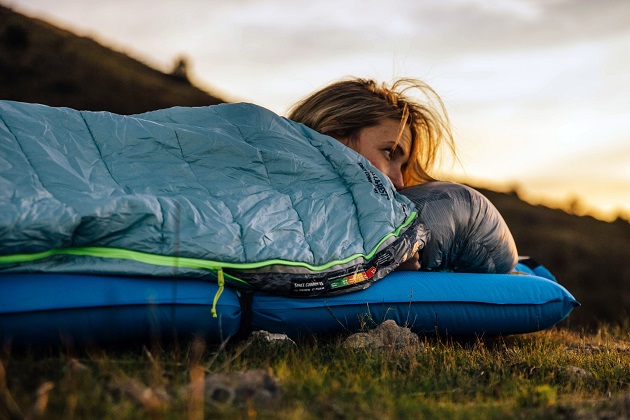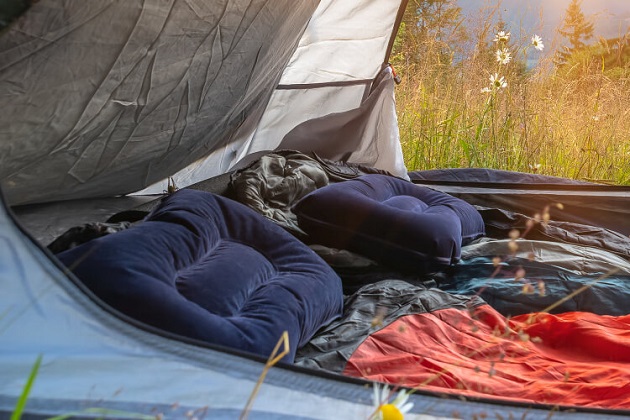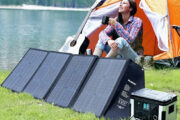If you think you know what a good night sleep is, wait till you’re out in the woods with street lights and blaring horns miles away, dozing off in the complete silence. While being outside in nature can transform your sleeping routine, the camping sleeping gear you have can make or break your experience. So in order to have the greatest time possible, let’s go over some tips and tricks and learn what should you bring for your next camping adventure.
Sleeping Bags: Types and Styles

When spending the night in the great outdoors, one of the most crucial items to have is a good sleeping bag. Sleeping bags are far more effective than a few blankets at storing your body heat. A well-made one will also fold up into a surprisingly little stuff sack. It is unquestionably a necessary camping sleeping gear component. There are eight different types of sleeping bags, each one with its specific features.
Rectangular Sleeping Bag
A non-tapered, right-angled design with a full or half-length zip on one or both sides is used in this style of a sleeping bag. The major advantage of this design is that you may move about freely within, just like you would beneath your quilt at home. This makes it less confining and less claustrophobic than other types of bags, and it is typically a more comfortable alternative for side sleepers. Sleeping bags insulate by retaining the heat generated by our bodies. Rectangular bags are less thermally efficient than bags with a tighter fit because their shape leaves more “dead air” for our bodies to heat. Furthermore, because the extra fabric used around the shoulders and foot box makes rectangular bags a little heavier, most models have a pretty low warmth-to-weight ratio.
Semi Rectangular Sleeping Bags
This kind of sleeping bag is a good medium between a mummy-style sleeping bag and a rectangle sleeping bag, with a slightly tapered shoulder region to prevent draughts from seeping in at the collar and a bit more room around the feet than mummies. These semis are a fantastic alternative for campers who need a bit of additional warmth but don’t want to feel confined.
Mummy Style Sleeping Bags
Mummies are the most popular form of sleeping bags, thanks to their outstanding warmth-to-weight ratio, minimal bulk, and ability to produce a draught-resistant, cosy cocoon that maximises warmth in chilly circumstances. Mummies have a highly tapered, streamlined design with a snug fit around the feet, a bit extra breadth in the hip and shoulder area, and a hood that can be cinched completely to allow you to “batten down the hatches” and maximise heat retention when temperatures are really low.
Mummies’ tapering form also means that less fabric is used in their manufacturing, making them lighter and more packable than most other varieties of sleeping bags. Mummies are also considerably more thermally efficient than their looser-fitting counterparts since there is less dead air for your body to heat within the bag. The major – and maybe only – complaint levelled about mummy bags is that their form-fitting shape can feel confining. However, if you’re camping in three or four seasons, this is a minor price to pay for the cosiness and warmth they provide.
Double Sleeping Bags
Double sleeping bags, which are designed to suit two adult sleepers, are perfect for camping excursions with a loved one or a close friend. While there are a few exceptions, most double sleeping bags are rectangular in shape, which means they provide plenty of space and flexibility but lack the insulating capacity necessary for cool-weather camping. Some double bags can also be changed into single bags through a halfway zip, letting you and your companion split up your space even more.
Pillows

While pillows may appear insignificant and are sometimes ignored, they may be the difference between sleeping like a baby and tossing and turning all night. If you’re one of those people who regularly wake up with a cramped neck you should definitely carry the extra weight of the pillow in your backpack. Otherwise, you can use your clothes, your luggage, or conventional pillows from home to support your head. There are many different types of camping pillows available to meet a variety of demands, and there are other reasons why you may want to purchase a camping cushion even if you are only going vehicle camping. Let’s go through this in-depth, and at the end, you’ll know if you need one or not.
Compressible foam is a type of foam that is made up of tiny pieces that compress extremely effectively. They will include a stuff stack or bands to put around the cushion. They are more expensive than inflatable camping pillows but offer a better level of softness and comfort. This pillow’s surface is generally considerably softer than that of inflated camping pillows.
This choice is the lightest and most likely the least costly. It’s simply a small camping pad in which you blow up a bag of plastic with your lips. The texture of the pillow varies, but many camping pillows have a fuzzy, nonslip texture made of polyester. You may anticipate support from these pillows, but not a great level of comfort until you alter the cushion with a fleece jacket or whatever you have on hand.
The difference between an ordinary pillow and a camping pillow of this type is that they are smaller and, in some cases, have two elastic bands on the end of the pillow, allowing the pillow to be rolled up and fed through the bands to maintain the rolled-up shape, making it more compact and convenient to carry with you.
Sleeping Mats

A sleeping mat is almost as vital as a sleeping bag because it is mostly what keeps you warm from the chilly ground. When you lie in your sleeping bag, the insulation compresses, rendering it inefficient at holding warm air because the majority of it is pushed out. There is nothing that can keep the warmth from escaping to the ground via conduction. Sleeping mats are typically constructed in one of three ways: self-inflating, non-self-inflating, or closed cell foam mats. Each of these provides a unique method of trapping air and isolating the body from the ground, and each has its own set of advantages and disadvantages.
These mats, which are lightweight but take up more space than other choices, provide insulation through closed air pockets inside the foam substance. These trap air within the foam and keep you warm against the chilly ground. These foam mats will not collapse since they are composed of closed air cells (no air can escape each cell). As a result, they are stiffer and perhaps more unpleasant to use. As a result, they will take up more room and must be rolled when stored.
Due to their lightweight but compressible nature, self-inflating mats are arguably the most popular among campers. Self-inflating mats operate by absorbing air when the valve is open, causing the foam to expand. They are made internally of foam packed inside an airtight shell. Because of the kind of foam utilised (open cell), they are compressible, making them more comfortable and simpler to pack than closed-cell foam mats. The amount of foam utilised inside the mat determines the level of comfort and insulation provided, which typically results in a trade-off with weight and expense.
When you need to carry as little weight as possible, closed-cell foam mats are an obvious choice, however lightweight self-inflating mats are also available. Keep in mind that if you’re camping in the winter, you might want to bring a warmer mat, or perhaps two.


